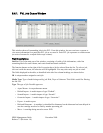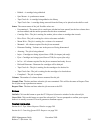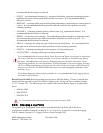
Clear List. Clears the list of mount requests. Note that this does not cancel any mount requests, but just
removes them from the list. Pending mounts will reappear in the window as the PVR periodically retries
the mounts. This can be useful for removing stale mount requests that, for some reason, never issued a
completion message to SSM. When this button is clicked from any SSM session, the Tape Mount
Requests windows on all SSM sessions will be cleared.
8.6.6. Administrative Tape Dismounts
HPSS provides the ability to administratively command a tape dismount in unusual situations, such as
when an administrator wants a tape dismounted without waiting for HPSS to do so, or when HPSS is
unable to do so due to a failure.
Administrative dismounts should only occur in exceptional error circumstances. Dismounting a tape may
cause the operations being performed on that tape to fail. A library dismount operation is unlikely to
occur while a mover has the device reserved for I/O.
Use the Devices and Drives list window to issue a dismount for the desired device/drive entry. A
confirmation window will pop up requiring you to confirm the dismount request.
8.7. New Storage Technology Insertion
As more advanced storage technology becomes available, there may be a need to replace used storage
media with newer volumes. HPSS provides a procedure for making this change. The procedure retires the
old volumes, introduces new volumes, moves the storage segments from the old to the new, and then
removes the old volumes.
The volume retirement feature is provided to facilitate new technology insertion. HPSS will not select a
retired volume to receive a new storage segment. In every other way, retired volumes behave normally.
Storage segments on retired disk volumes can be read and written normally. Storage segments on retired
tape volumes can be read normally. Attrition of segments through the usual processes of file deletion and
migration will cause retired volumes to gradually become empty.
A retired volume has the characteristic that its VV Condition is something other than RWC, and cannot
be changed to RWC. New storage segments can be created on a volume only when the VV Condition is
RWC, so new segments are not created in retired volumes.
To replace old technology volumes with new, the following outline serves as a guide, but the
administrator should be aware that the procedure will probably need to be tailored to the specific
circumstances of the change. This procedure applies to both tape and disk volumes:
1. Change the storage class definition by deleting and then recreating it using the same storage class
ID. The new storage characteristics must reflect the characteristics of the new storage technology
volumes. In addition, they should be compatible with other storage levels in the hierarchy.
Changes made to the storage class definition do not affect volumes that exist when the changes
are made. The characteristics of established volumes stay the same throughout their lifetimes.
Changes made to the storage class only affect the characteristics of volumes created after the
change is made.
2. Stop and restart the Core Servers and Migration Purge Servers that use the modified storage class.
These servers cache storage class definitions in memory and should have the opportunity to
HPSS Management Guide November 2009
Release 7.3 (Revision 1.0) 291


















